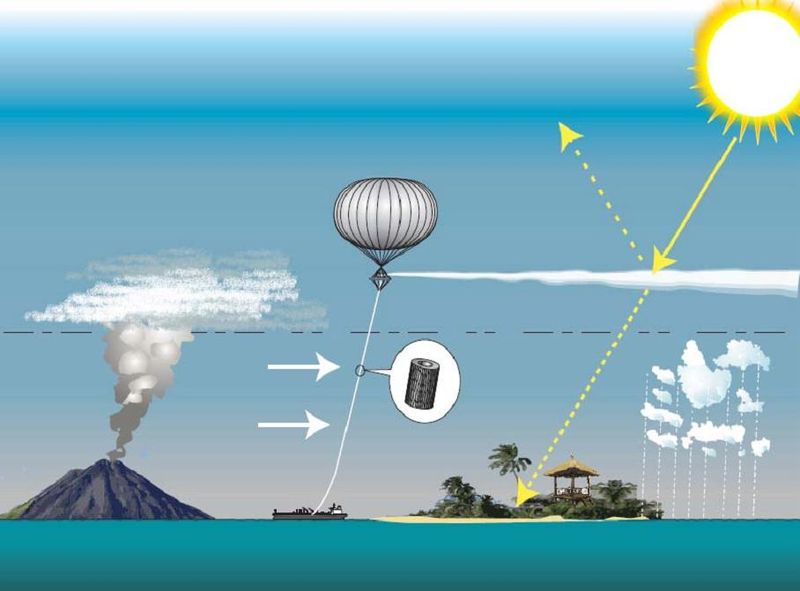Geoengineering and its policy implications were hot topics at this year’s Science in Public conference. The subject raised questions such as how is geoengineering portrayed in the media and what does this mean for the acceptance of geoengineering technologies? Dr Rusi Jaspal and Professor Brigitte Nerlich discuss their research into media representations of geoengineering and how these shape the hopes and fears of the public…
Geoengineering promises to alter global climate patterns and thereby avoid the potentially catastrophic consequences of climate change. Implementing various types of climate engineering options is a huge, but still mainly speculative, technological problem. It throws up immense political, governance, social and ethical problems. However, we should not forget that it is also a linguistic problem. As I. A. Richard said in his Philosophy of Rhetoric, a “command of metaphor plays a role in the control of the world that we make for ourselves to live in” (see p. 155). This means that we make the world we live in by the language we speak in it, especially through the use of metaphors. Metaphors make us see one thing in terms of another and then act in specific ways according to this new way of seeing. What does this mean for geoengineering? What language is emerging in the context of geoengineering? How might people respond to such language?
To explore these questions, we undertook two studies as part of a larger project considering climate change as a complex social issue. In the first study, we examined a small body of articles published in trade magazines between 1980 and 2010, with the majority being published between 2006 and 2009. In a second follow-up study we analysed a small sample of articles published in UK national newspapers between 1 January 2010 and 15 July 2013. Overall, the coverage of geoengineering lags far behind coverage of other geoscientific developments, such as carbon capture and storage and fracking, for example.
The findings of our first study indicate that those trying to promote geoengineering use a series of powerful metaphors circling around one master-argument, namely that if emissions continue to rise we face global catastrophe and geoengineering might be the only option left to avert it. The three main conceptual metaphors supporting this master-argument were:
- The planet is a machine (car, heating system, computer), which manifested itself in scientists’ and journalists’ claims that geoengineering can ‘fix’ the planet, that it can be used to manipulate the planet’s thermostat and so on;
- The planet is a body, which manifested itself in people talking about building a sunshade for the planet or applying suncream, sunblock or sunscreen to it; and
- The planet is a patient, which manifested itself in talk of applying medical treatment to the planet of curing the planet’s addiction to carbon and so on.

Honeywell’s iconic thermostat, also called The Round. (Credit: Flickr user midnightcomm)
Just after we had carried out the first study, the SPICE project (which aimed to assess the feasibility of injecting particles into the atmosphere in order to manage solar radiation) was launched and attracted some media attention, especially after it was cancelled. We imagined that the language used to talk about geoengineering might change after this event. When we looked at the UK press coverage, we found a pronounced difference between right- and left-leaning newspapers. The Times and The Daily Telegraph (right-leaning) still displayed some of the optimism we had found in the trade magazines (and the scientists who were quoted in them), while The Guardian and The Independent (left leaning) focused more on potential threats posed by geoengineering. The Times and The Telegraph saw geoengineering as a last option in the war against climate change, as a palliative and a silver bullet (linking back to the conceptual metaphors used in the trade press). They also, and more importantly, began to normalise geoengineering, either by comparing it to sci-fi but pointing out that it was becoming a reality, by linking it back to successful experiments in cloud seeding, or by comparing geoengineering to everyday activities we take for granted, such as stepping into our cars.

The technology that would have been used in the SPICE experiment. (Credit: Hugh Hunt)
By contrast The Guardian and The Independent focused on the threats posed by geoengineering and argued that it distracts from climate mitigation (what others have called the moral hazard argument) and by pointing to many uncertainties, both scientific and social. Some articles also framed the technology as ‘fascist’. This contrasts strongly with the normalising discourse emerging within the more right-leaning press.
Readers of press articles about geoengineering are confronted with a wide range of linguistic and metaphorical arguments and framings. These need to be thought through in terms of the world they might want to live in or be forced to live in terms of individuals and communities. This is not easy, as this technology is highly speculative, would be a global enterprise and would have very uncertain and unpredictable local impacts. As a means of understanding how people might respond to complex social and linguistic constructions of geoengineering, we have drawn upon Identity Process Theory. This social psychological theory argues that we need to maintain appropriate levels of particular ‘identity principles’ in order to construct a positive identity:
- Continuity – thread connecting past, present and future and, at a group level, survival;
- Self-efficacy – control and competence over one’s life and future;
- Self-esteem – a positive self-conception;
- Distinctiveness – differentiation from relevant others.
It is likely that metaphors which construct geoengineering as a danger to the human species could threaten people’s sense of continuity, while those that normalise geoengineering could in fact safeguard our sense of continuity over time by denying that anything would change. Metaphors that depict geoengineering as the only means of regaining control of the planet’s climate could bolster people’s sense of self-efficacy. The notion that we are supporting a technology that could benefit our planet may help us to derive a positive self-conception, enhancing feelings of self-esteem.
We are more likely to endorse or embrace phenomena that provide us with high levels of these principles and to avoid or deny things that jeopardise our feelings of continuity, self-efficacy and so on. Thus, the metaphors which make us view geoengineering in terms of either threats or benefits to these principles are clearly important in shaping our perceptions and, ultimately, our future engagement with geoengineering at both individual and group levels. This is no trivial matter. As the sociolinguist Suzanne Romaine said: “It matters which metaphors we choose to live by. If we choose unwisely or fail to understand their implications, we will die by them.”
By Dr Rusi Jaspal & Professor Brigitte Nerlich
References
Jaspal, R. & Nerlich, B. (2013). Media representations of geoengineering: Constructing hopes and fears. Paper presented at the Science in Public Conference, University of Nottingham, UK, 23 July 2013.
Nerlich, B. & Jaspal, R. (2012). Metaphors we die by? Geoengineering, metaphors and the argument from catastrophe. Metaphor and Symbol, 27(2), 131-47.
Dr Rusi Jaspal is Lecturer in Psychology and Convenor of the Self and Identity Research Group at De Montfort University, Leicester. E-mail: rusi.jaspal@cantab.net
Professor Brigitte Nerlich is Professor of Language, Science and Society and Director of the Leverhulme Program: Making Science Public at the University of Nottingham. E-mail: Brigitte.nerlich@nottingham.ac.uk





Pingback: Geoengineering and (un)making the world we want...
Pingback: Making Science Public » Geoengineering and the (un)making of the world we want to live in